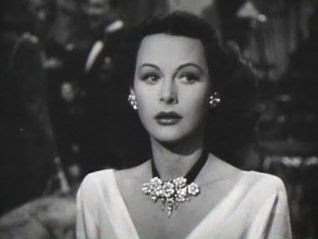Hedy Lamarr and The Secret Communication System
The above scenario is not a scene out of a Hollywood movie, it happened in real life. The woman was Austrian actress Hedy Lamarr (1914-2000) and the man composer George Antheil and together they came up with a secret communication system to use against the Nazi's that is the basis of technology that still affects communication systems today. Yes, Hedy Lamarr, the dark and sultry actress who slinked across screens during the 1930's and 1940's in movies like ALGIERS with Charles Boyer, and arguably her most famous film role as Delilah in Cecil B. DeMille's SAMSON AND DELILAH with screen hunk Victor Mature. She was called 'The Most Beautiful Woman' in Hollwood but she was overshadowed by other European screen goddesses like Marlene Dietrich and Ingrid Bergman. Not many people knew that there was actually a brain behind that beautiful face.
Born Hedwig Kiesler in November of 1914, she was the spoiled, pampered only daughter of a well-to-do Jewish banker and his musician wife. By the time Hedy was 19, she'd studied acting with famed director Max Reinhardt, appeared on stage and made several films including the notorious 'art' film ECSTASY where she not only swam in the nude but also simulated orgasm on screen. Legend has it that her director had to stab her with a pin in order to get the responses that he wanted.
It was her marriage to Fritz Mandl in 1933 that gave Hedy the basic idea for the technology that she and Antheil came up with. Mandl was a shady character, an arms manufacturer thirteen years her senior, who had no moral compass. He would sell arms to pretty much anyone including the Nazis (he spent the war in Argentina becoming a close advisor to Juan Peron.) Mandl was also a control freak who kept Lamarr a virtual prisoner, preventing her from pursuing her acting career. He basically never let her out of his sight, when she wasn't acting as his hostess, entertaining and dazzling foreign leaders which included Hitler and Mussolini, he was taking her to business meetings with clients. Hedy clearly was paying attention to the conversations between her husband and his clients, particulary that Mandl had been working on a way to control torpedoes by radio. Finally having enough of her sadistic husband, Hedy escaped by drugging her maid and taking her clothes. She made her way to Hollywood where she was offered a contract by Louis B. Mayer and MGM. Mayer changed her last name to Lamarr after the silent film star Barbara Lamarr.
So Hedy's now in Hollywood, making movies for MGM when she meets Antheil. When she and Antheil becan talking, Hedy remembered that her ex- husband had been interested in control systems, and had conducted research in the field, particulary in regard to torpedoes. Some torpedoes were guided by radio signals, but the problem was that enemy ships could hear the radio signals sent from the firing ship, which meant that they could stop the signal from reaching the torpedo. Hedy came up with concept of 'frequency hopping' after their duet on the piano. Just as Antheil had kept changing the key as they played the piano, a ship could simply flip from one radio channel to another, that way the enemy couldn't hear the signal. She also knew that how to help the signal from the ship reach the torpedo's radio. Both radios had to change channels together.
Antheil contribution was to suggest that the device by which this synchronization could be achieved. He had once composed a piece using 16 synchronized player pianos. After working for several months with a professor from the California Institute of Technology who helped them iron out the bugs, they applied for a patent on June 16, 1941. Their invention would use slotted paper rolls similar to player-piano rolls synchronize the frequency changes, it even called for 88 frequencies just like the number of keys on a piano. It also specified that a high-altitude plane could steer the torpedo from above. They received their patent for the 'Secret Communication System' in 1942. However the U.S. Navy never used their idea, concluding that the device would be too bulky to fit into a torpedo. Antheil however insisted that the device could be made small enough to fit into a watch.
Instead of her 'secret communication system,' Hedy's contribution to the war effort ended up being the $7 million dollars she raised selling war bonds in a single evening. Hedy and Antheil never pursued their invention further and by 1959, the patent had expired. However the concept was taken up by engineers at the Sylvania Electronic Systems. The device they came up, which used electronics instead of piano rolls, was installed on the ships that were sent to blockade Cuba during the missile crisis in 1962. Subsequent patents in frequency changing have referred to the Lamarr-Antheil patent as the basis for their work, and their concept lies behind the principal antijamming device used today.
In 1997, Hedy Lamarr received the Pioneer Award from the Electronic Frontier Foundation. Lamarr was clearly a woman ahead of her time. The idea that she came up with along with George Antheil simply had to wait for technology to catch up with it. One has to wonder that if someone other than an actress and a composer had come up with the idea, if would have been taken more seriously at the time.
Sources:
Barton, Ruth. Hedy Lamarr: The Most Beautiful Woman in Film. Lexington: University of Kentucky Press, 2010.
Gaines, Ann. Hedy Lamarr: Discover the Life of an Inventor. Vero Beach: Rourke Publishing LLC, 2002.




Comments